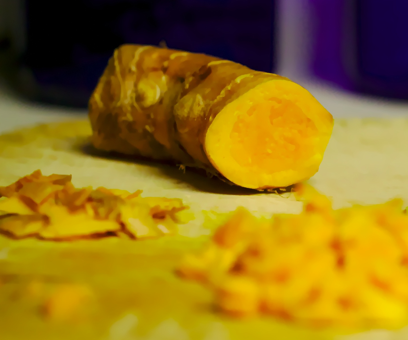Common Name: Turmeric
Scientific Name: Curcuma longa
Alternative Names: Aushadhi (Sanskrit “Herb”), Gauri (Sanskrit “The One Whose Face is Light and Shining”), Haldi (Hindi), Haridra (Sanskrit “The Yellow One”), Indian saffron, Jiang huang (rhizome), Kanchani (Sanskrit “Golden Goddess”), Yu jin (root tuber), Yellow ginger.
Uses:
- Turmeric is a useful anti-inflammatory in the management of arthritis (osteo and rheumatoid), skin disorders, equine asthma (heaves) and auto-immune disorders.
- Can be applied topically to reduce inflammation, especially inflamed skin.
- Emotional Support: Can be administered to horses exhibiting anger, aggression or anxiety, effectively dealing with an ‘inflamed mood’.
- Anti-platelet activities offer protection to the cardiovascular system.
- Detoxifies and regenerates liver tissue, protecting against hepatotoxicity and helping to treat viral hepatitis.
- Calms the stomach and aids digestion.
- Prevents and treats peptic ulcers by reducing gastric acid secretions.
- Demonstrates anti-tumour / anti-cancer activities, particularly helping to inhibit cancers of the skin, colon, mouth, oesophagus, lungs, stomach, pancreas, liver, prostate and mammary tissue.
- Protects against DNA damage in lymphocytes, explaining its role in helping the body to fight bacterial and viral infections and fight cancers.
- Aids recovery from adrenal fatigue.
- Highly toxic to Salmonella.
- The curcumin in Turmeric helps to curb insulin resistance, high blood sugar, high cholesterol levels and other metabolic conditions.
- Preliminary studies in rodents have shown that that curcumin suppresses the growth of fat tissue.
Combinations:
- Combine with Frankincense (Boswellia serrata) in the management of arthritis.
- Combine with either St Mary’s Thistle / Milk Thistle (Silybum marianum) of Dandelion root (Taraxacum officinale radix) to restore liver health.
Contraindications:
- Seek advice before administering to a horse on anti-coagulant or anti-platelet drugs (usually prescribed for equine thrombotic diseases).
- High doses may cause skin rash and photosensitivity.
- Do not apply topically to broken skin.
Feeding Notes:
- Curcumin (the active constituent of Turmeric) is not well absorbed orally. To improve absorption, administer in a lipid base (i.e. feed with a dietary fat such as canola or flaxseed oil).
Bibliography
- Bartram, T 1998, ‘Bartram’s Encyclopaedia of Herbal Medicine’, Constable & Robinson Ltd, London
- Duke, J. 2002, ‘Handbook of Medicinal Herbs’, 2nd Edition, CRC Press, U.S.A.
- Ejaz, A; Wu, D; Kwan, P and Meydani, M, 2009, ‘Curcumin Inhibits Adipogenesis in 3T3-L1 Adipocytes and Angiogenesis and Obesity in C57/BL Mice’, in Journal of Nutrition, 139/5, pp.919-925
- Grieve, M 2014, ‘Botanical.com’ [Online], accessed 5th January 2014, http://botanical.com
- Hechtman, L. 2012, ‘Clinical Naturopathic Medicine’, Churchill Livingstone – Elsevier Australia, Chatswood, Australia
- Hoffman, D. 2003, ‘Medical Herbalism: The Science and Practice of Herbal Medicine’, Healing Arts Press, Vermont
- Khare, C.P. 2007, ‘Indian Medicinal Plants: An Illustrated Dictionary’, Springer Science + Business Media LLC, New York
- Marciano, M 2014, ‘The Naturopathic Herbalist: Botanical Medicine for the Medical Student’ [Online], accessed 31/01/2014, http://thenaturopathicherbalist.com/
- Sayre, L 1917, ‘A Manual of Organic Materia Medica and Pharmacognosy’, Fourth Edition, P. Blakiston’s Son and Co., U.S.A.
- Wynn, S. and Fougère, B. 2007, ‘Veterinary Herbal Medicine’, Mosby-Elsevier, Missouri

